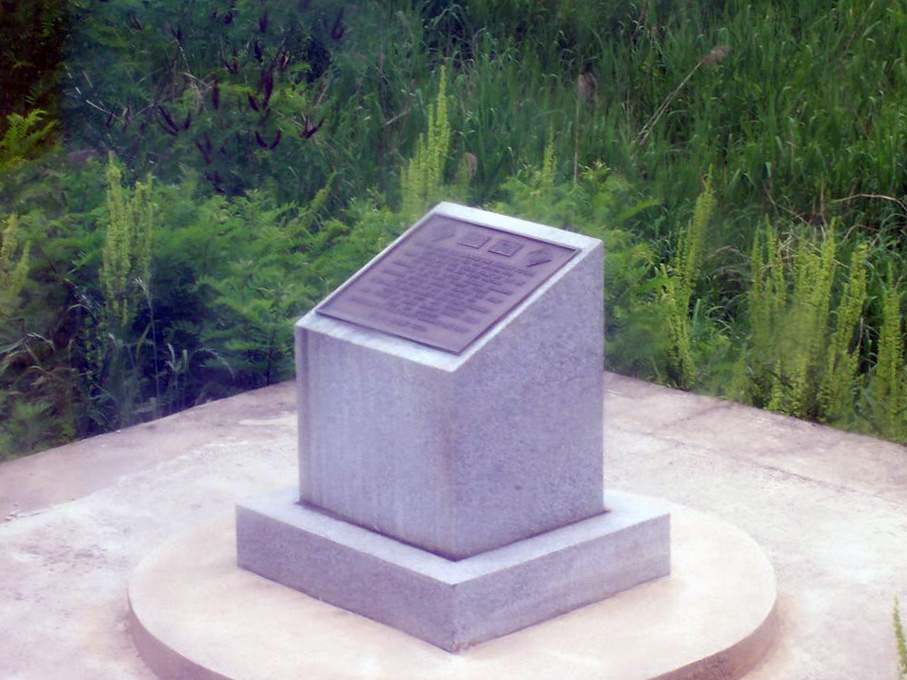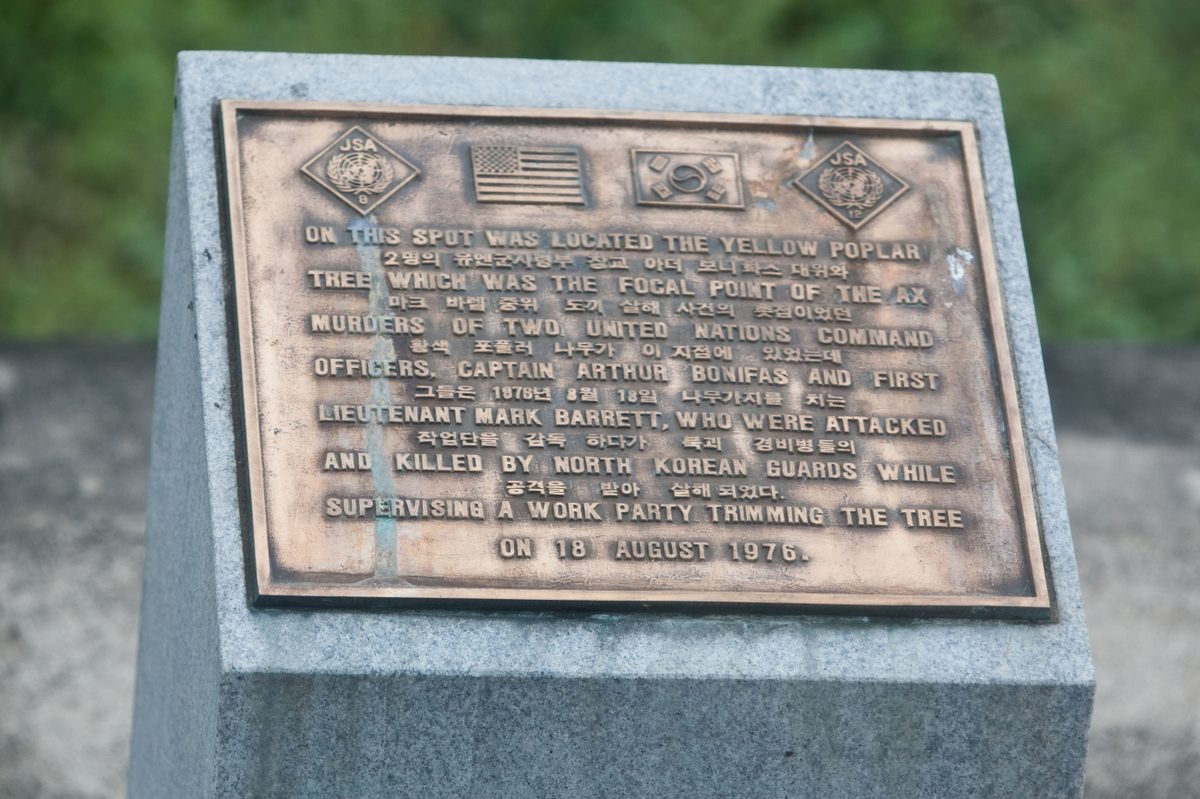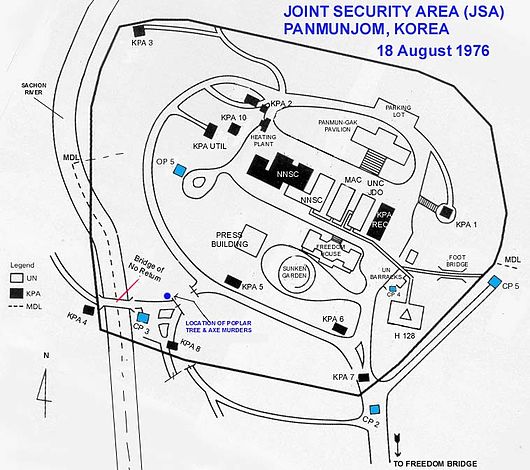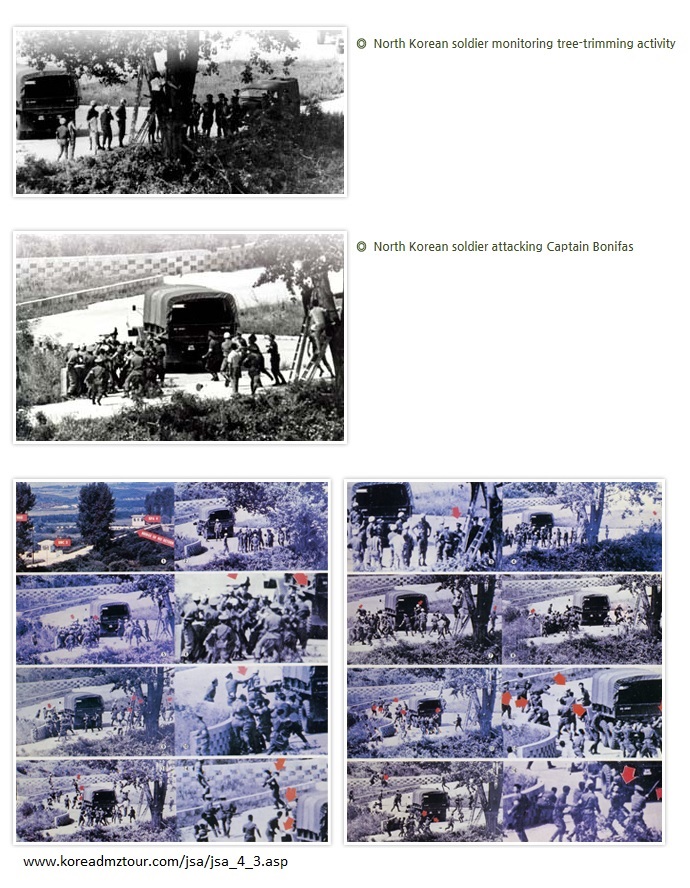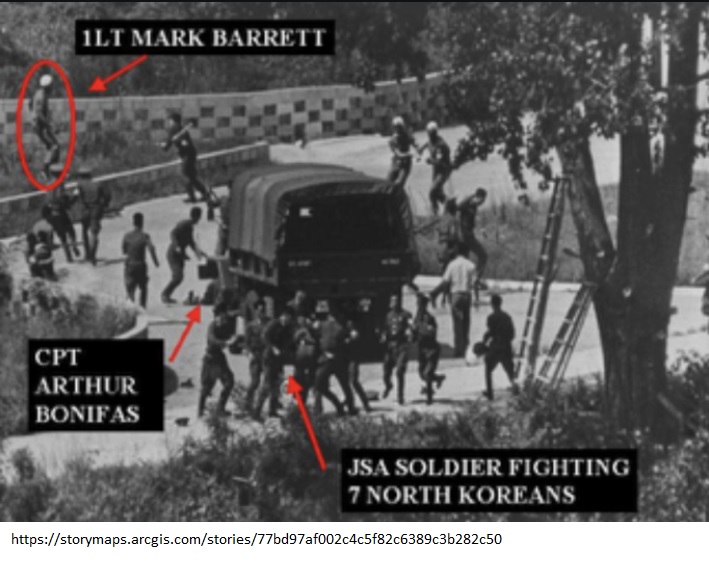Korean Axe Murder Incident Memorial
Details:
To the east of the Y-junction in front of the CP3 guardhouse. (See ‘Other images’ below for the exact map location.)
MarkerA trapezoidal stone block with a square plinth on a one-step circular base bearing a rectangular metal plaque on an angled surface. The plaque is inscribed in English and Korean in raised lettering. The place where the memorial is erected is the place where a former poplar tree was planted. The tree was the object of the 1976 axe murder incident and was deliberately left standing after Operation Paul Bunyan (an operation that cut down the tree with a show of force to intimidate North Korea into backing down). It was replaced by this memorial in 1987.
The conflict revolved around a poplar tree located near the Bridge of No Return at the periphery of the JSA. In 1976, the tree was 30 meters tall which blocked the line of sight between a Checkpoint (CP 3) and an observational post (OP 5) of the United Nations Command (UNC).
On one occasion before the incident, a group of U.S. troops was confronted by North Korean soldiers at a gunpoint near CP 3. Unable to observe the situation from distance, the U.S. commander in JSA Arthur Bonifas was went to the site who successfully brought back the U.S. troops. Bonifas would later become one of two Americans killed in the Axe Murder Incident.
On August 18, 1976, a group of 11 American and South Korean soldiers went into the JSA to trim the tree (the officers included Captain Arthur Bonifas and First Lieutenant Mark Barrett). No one in the working group was wearing sidearms.
After the trimming began, 15 soldiers of the Korean People's Army (KPA) led by Senior Lieutenant Pak Chul, nicknamed "Lt. Bulldog" due to a history of confrontations, appeared to observe the trimming. After 15 minutes, Pak abruptly demanded trimming of the tree to be stopped as he claimed that "Kim Il Sung personally planted it and nourished it, and it's growing under his supervision". Captain Bonifas turned his back on Lt. Pak and ignored him.
After being ignored by Bonifas, Lt. Pak sent a messenger across the Bridge of No Return. Minutes later, a North Korean military truck loaded with about 20 KPA soldiers armed with crossbars and clubs came to the site via the bridge. Lt. Pak again demanded the working group to stop. When Cpt. Bonifas ignored him, he ordered North Korean troops to attack the working group. Cpt. Bonifas was knocked to the ground and beaten to death by at least 5 KPA soldiers, while Lt. Barrett jumped over a wall and fell into a 4.5-meter depression after being attacked. The fight lasted for 20 to 30 seconds before UNC guards dispersed the KPA soldiers and recovered the body of Bonifas.
However, Lt. Barrett wasn't found until 90 minutes later during which he has been attacked by KPA soldiers in the depression and sustained fatal injuries. A rescue group was dispatched to recover him but unfortunately, he died en route to a hospital in Seoul. The attack was captured by UNC officers at CP NO.3 and OP No.5 using a black-and-white camera and a movie camera.
In response to the incident, the UNC determined that instead of trimming the branches that obscured visibility, they would cut down the tree with the aid of overwhelming force. The parameters of the operation were decided in the White House, where US President Gerald Ford had held crisis talks. Ford and his advisers were concerned about making a show of strength to chasten North Korea without causing further escalation. The operation, named after the mythical lumberjack Paul Bunyan, was conceived as a show of force by the US and South Korea and was carefully managed to prevent further escalation.
Although the operation was carried out peacefully, there was concern that it could spark a wider conflict. The incident led to increased tensions along the Korean Demilitarized Zone but did not develop into full-scale war. Some shots were fired at the US helicopter that carried Major General Morris Brady. It circled Panmunjom later that day, but no one was injured.
Source of information: The Historical Marker Database, en.wikipedia.org, storymaps.arcgis.com
Source of photos: www.atlasobscura.com, en.wikipedia.org, www.koreadmztour.com
Monument Text:
ON THIS SPOT WAS LOCATED THE YELLOW POPLAR
TREE WHICH WAS THE FOCAL POINT OF THE AX
MURDERS OF TWO UNITED NATIONS COMMAND
OFFICERS, CAPTAIN ARTHUR BONIFAS AND FIRST
LIEUTENANT MARK BARRETT, WHO WERE ATTACKED
AND KILLED BY NORTH KOREAN GUARDS WHILE
SUPERVISING A WORK PARTY TRIMMING THE TREE
ON 18 AUGUST 1976.
Commemorates:
People:
Units:
United States Army
Wars:
Cold War
Other images :

